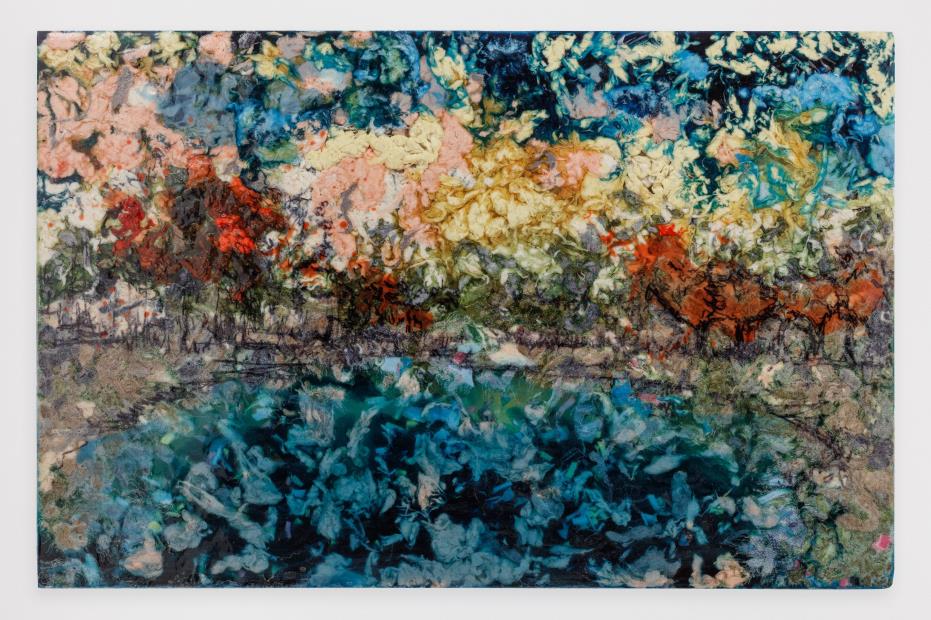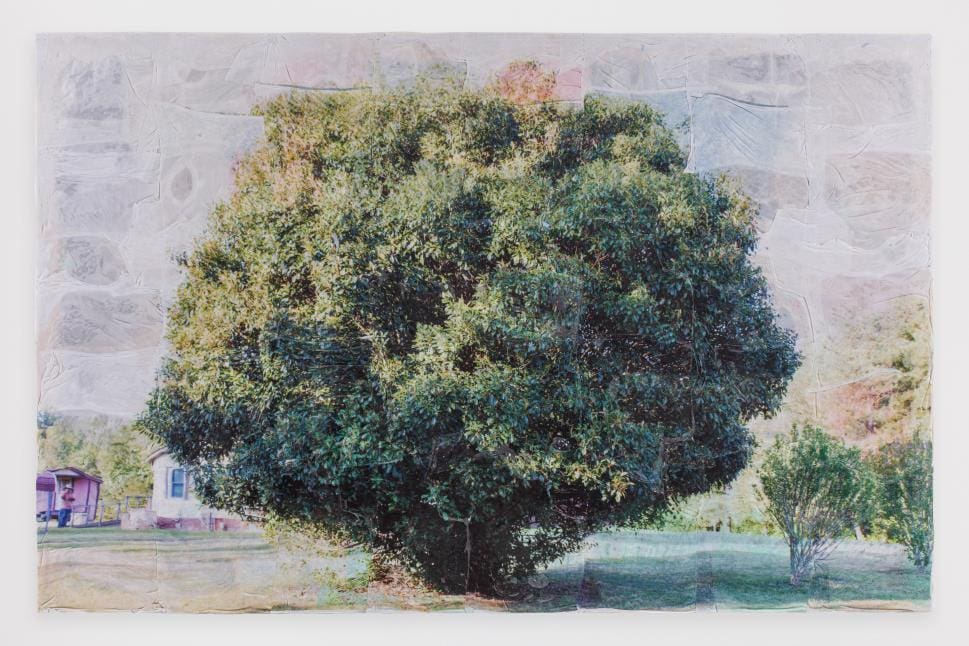As I walked the sidewalk toward the Regen Projects gallery building off busy Santa
Monica Boulevard, I heard a piercing scream. The brief, cryptic moment startled me. Of course,
this is Los Angeles, where heavy traffic and detached voices compile the fabric of daily life. I
shrug it off and walk into the gallery. I read the presser and suddenly, another piercing scream.
Both screams are a part of the soundscape that Kevin Beasley has patched together with this
multi-media exhibition. Rooftop speakers externalize the soundscape, blending it with the one
already active along this Hollywood stretch. Beasley focalizes blending. Though the title On Site,
might suggest a singular site, it may be a blend of sites. Street and gallery sound blend to
reminds us of the arbitrary boundaries that physical space can construct. His canvas-like slabs
blend raw cotton, t-shirts, dresses, and resin. A large utility pole centers one gallery room – the
source of the sound recordings – blending different artistic forms. Histories of the American
south, cultures of clothing and modern infrastructure blend to encourage reflection on the
contexts of Beasley’s art, space, and time.

Kevin Beasley
the lagoon
2022
Polyurethane resin, raw Virginia cotton, altered housedresses,
altered t-shirts, Sharpie transfer 39 x 60 x 2 inches (99.1 x 152.4 x 5.1 cm)
© Kevin Beasley, Photo: Paul Salveson, Courtesy Regen Projects
In her book Vibrant Matter, Jane Bennett urges a new perception of “vital materiality.”
Her lens notices nonhuman life, specifically the life of vital materials to which we might not
ascribe the word “life”. She cultivates, “patient, sensory attentiveness to nonhuman forces
operating outside and inside the human body” (xiv). Nonhuman “actants” collaborate with
humans in “assemblages” to impact the world. In an Art21 film interview, Kevin Beasley
describes his choice to use Virginian cotton as a part of his slabs, “As materially oriented as I am
it’s all because there is a context for those materials.” The Virginian cotton, clothing and
everyday street objects recall local and international contexts of geography, subjugation, and
industry. These contexts, like sweat-shop production for instance, have been structured to
operate beyond our everyday gaze, broadening the vital materiality of a t-shirt far beyond how
we adorn our bodies. Contexts fuel the aesthetic of the work, and the aesthetic is important. The
pieces carry a natural lushness, some of them resembling flower beds, or coral reefs. Abstraction
mingles with realism, occasionally explicitly referencing some of the southern landscapes that
Beasley hailed from. They take up and refigure cultural contexts to recognize them and then they
reformulate them into something aesthetically fresh from the individual materials. Bennett’s
ideas can provide a view of how the individual materials work together to expand culture and
physical space.
Sound renders the vitality of the exhibition space three dimensional. After the initially
jarring screams, I didn’t hear another as I browsed. Conceivably, a visitor could explore the
exhibition without hearing one at all. My visit, then, was inflected by the randomness of the
movement of the recorded soundscape. In this way, the collapsing of the physical art space
occurs and the soundscape acts on independent volition. Of a 2019 exhibition of similar material,
Beasley said he was interested in spurring people to ask what their relationship to the material.
He remarked, “setting up a scenario where people can take the time is as much as I can really
offer.” He seems ambivalent about making an argument and the work shows that. Rather, he
compiles the contexts with his visual and sonic materials, and allows them to work on the
spectator, recognizing that each spectator is going to interact differently with the material.

Kevin Beasley
In my dream I saw a landscape II, 2022
Polyurethane resin, raw Virginia cotton, confetti housedresses,
housedresses, t-shirts 74 x 112 x 2 inches (188 x 284.5 x 5.1 cm)
© Kevin Beasley, Photo: Paul Salveson, Courtesy Regen Projects
The vital life of Beasley’s materials is multilayered. If we read them as vital materials,
we can read them as containing places, people, and histories, some of which are actively at risk
of erasure. These materials are used and manipulated by humans, but by their very functions
impact human life worlds. His cotton comes specifically from Virginia, but this exhibition links
his work to property that he owns in Louisiana, further broadening his scope across the American
south. His histories stretch back to slavery, and the destruction of southern land to derive cotton
capital for plantation owners and corporate interests. Beasley’s slabs, like our American present,
are haunted by the histories of subjugation that acted as foundations of our economic, political,
and social structures. The actant of cotton here is a material agent that literally stratified and
governed human life.

Kevin Beasley
Site I, 2022
Polyurethane resin, raw Virginia cotton, altered t-shirts,
Housedresses 74 x 55 1/1 x 2 inches (188 x 141 x 5.1 cm)
© Kevin Beasley, Photo: Paul Salveson, Courtesy Regen Projects
Clothing expands this scope. T-shirts and dresses are containers of individuals. Lives of
possible wearers are packed into the slabs, populating the pieces with individual histories. More
broadly, those personal histories are bound by the contexts of the vital networks that yield
clothing production and distribution. Perhaps some of these articles of clothing were hewn in
Chinese or Indonesian sweat shops, shipping through warehouses to a doorstep, fulfilling an
Amazon Prime order. Beasley’s material contexts become international ones, reminding us that
our local and national contexts are indelibly intertwined with those out of sight, out of mind
contexts beyond oceans. These contexts, of course, hinge on substantial categories of actants like
fossil fuels, electricity, waterpower, crucial to transforming raw cotton into a t-shirt – a packaged
piece of clothing into a bodily adornment. Within the slabs, raw cotton, and clothing meld
explicitly, but linkage of the vital histories requires time and attention.

Kevin Beasley
Grace, 2022
Polyurethane resin, raw Virginia cotton, altered t-shirts,
Dye sublimation t-shirts 108 x 167 x 3 inches (274.3 x 424.2 x 7.6 cm)
© Kevin Beasley, Photo: Paul Salveson, Courtesy Regen Projects
Space is muddled by these histories. The slabs reside in a gallery in Los Angeles, but
their histories, like the sound recordings, breach gallery walls. A utility pole stands as a nexus for
negotiating space. The pole occupies the middle of the second room of the exhibition, reaching
the ceiling, cords stretching around the room and connecting with speakers that ooze the
soundscape. The pole orders the space. The surrounding slabs depict a house, a large tree, and a
few other more abstract landscape images. The pole binds them, expanding the dimension of the
space to feel as though you’ve been transported a neighborhood of Virginia or Louisiana. An
expansive view of the utility pole reminds us of infrastructure.

Kevin Beasley
THE SOURCE, 2022
Wooden utility pole, powder-coated steel base, Coleman cooler,
Utility enclosure, aluminum pipe, aluminum pole arms, LED lights,
Midas mixer, Corwn Power amplifiers, bottle opener, Nike Cortez sneakers,
8 full range outdoor speakers, 2 outdoor subwoofers, 40 hours 8-channel audio
Installed Dimensions, overall: 14 x 16 1/1 ft (426.7 x 502.9 x 30.5 cm)
© Kevin Beasley, Photo: Paul Salveson, Courtesy Regen Projects
Bennett, characterizing “vital matter,” re-historicizes the major U.S.-Canada blackout of
2003, when the power grid abruptly went dark, leaving millions without power. She describes
the electrical grid as “a volatile mix of coal, sweat, electromagnetic fields, computer programs,
electron streams, profit motives, heat, lifestyles, nuclear fuels, plastic, fantasies of mastery,
static, legislation, water, economic theory, wire, and wood—to name just some of the actants”
(25). Her list sprawls, weaving together nonhuman forces at work outside direct lines of human
vision. The grid, like Beasley’s slabs, contains a myriad of separate pieces, the details of which
we can only see with a close glance. Space expands as the power of the pole projects sounds
outside the gallery building, but it also connects this space to the larger fabric of the
infrastructural grid that gather utility poles like this one. The vital network of power that
connects neighborhood to neighbor, state to state, and country to country culminates in the utility
pole.
Reading the utility pole with Bennett’s historicization of the 2003 blackout in mind
illustrates the fragility of modern infrastructural networks. Ours is a vital network that relies on a
mythical mastery that humans hope to utilize by populating environments. This infrastructure,
like the systems of slavery and clothing production, hopes to hide and erase the possible negative
consequences of reliance. The strength of Beasley’s work lies in his ability to take these
materials and create something aesthetically fresh, without divorcing his vital materials from
their contexts. He’s ambivalent toward making an argument, but his works allows us to consider
and sit with those contexts.
On site is on view at Regen Projects through June 25th